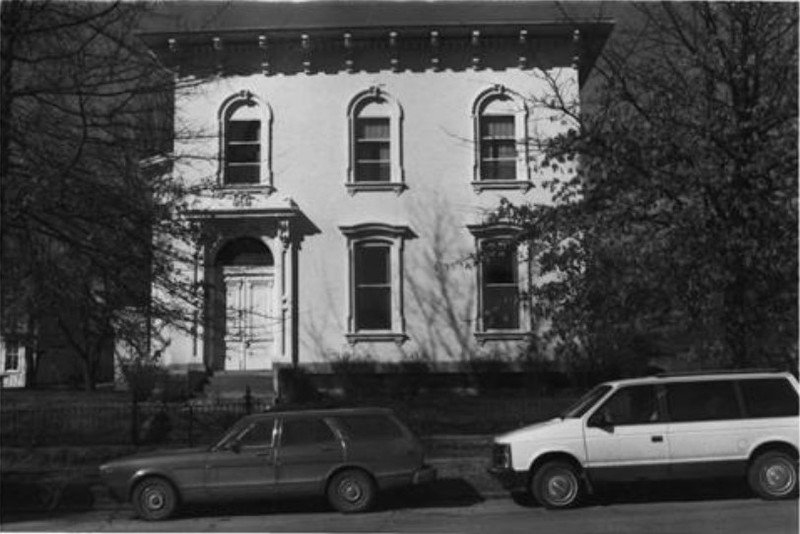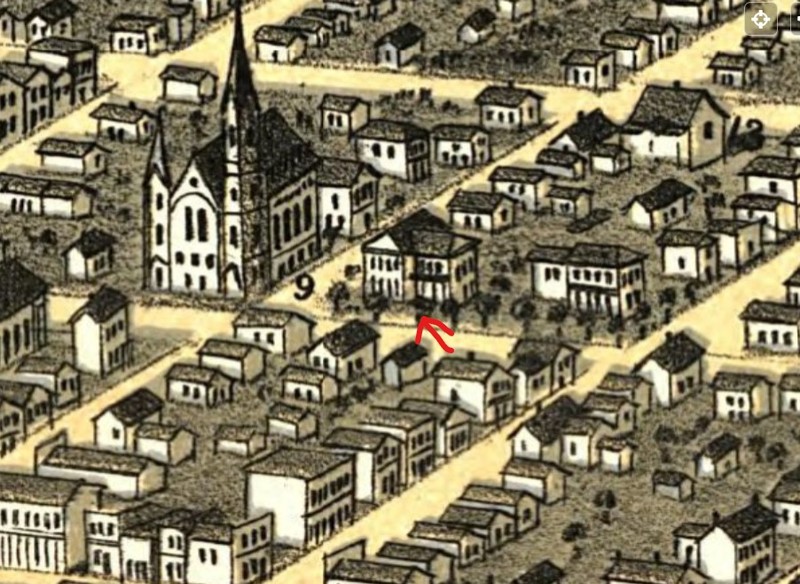Merritt H. Insley House
Introduction
Text-to-speech Audio
Images
Main facade of Insley House from NRHP documentation (Hagedorn 1986)

Insley House (red arrow) on Bird's Eye View of the City of Leavenworth, Kansas 1869 map (Ruger 1869)

Backstory and Context
Text-to-speech Audio
In July of 1860, before this house was finished, Merritt H. Insley was a hotelkeeper in Leavenworth. The 29-year-old lived in the hotel with his wife, Eliza (age 24). Insley owned real estate valued at $2,000 at that time, and personal property valued at $2,500. Twenty-four other people resided in the hotel in 1860. "Captain" Insley served in the US Army during the Civil War and was stationed at Fort Scott in 1863. By 1880, the banker and his wife shared their home on Seneca Street with two children: Harry E. (19) and Lillie E. (16); and two servants: a white housekeeper named Nelly Sullivan (18) and a Black coachman named Edwin Moore (35). The Insley daughter, Lillian, married Manford H. Carr in 1893. The Insleys sold their home on Seneca Street to Dr. William Walters in 1894 and moved to a smaller house in town.
Dr. Walters was a 39-year-old physician in 1900; the single man shared his home with his widowed father, Joseph Walter[s], a farmer (72). Dr. Walters was a Kansas native; his parents were born in Pennsylvania. In 1910, Dr. Walters and his father were joined in the home by a sister of the doctor, Nana Shaw, a married 48-year-old. Two servants also lived in the home: Veruis Eugrin (female, 32, a cook) and Clarance Eugrin (19, a laborer). Dr. Walters offered medical services from his home until his death in 1912.
Heirs of the physician sold the property in 1920 to David and Amelia Henckes; they did not appear in the 1920 census. The Henckes' house was converted into a boarding house by 1930. David A. Henckes was a veteran of the Spanish-American War born around 1876 in Iowa. His wife, Amelia L., was born in Austria in about 1885 and was married around 1907. The couple's daughter, Frances C., was born in Alaska; the 21-year-old worked as a public school teacher in 1930. Several other families rented space in the house in 1930: Homer Haug (39, a bookkeeper) and his wife, Alice H.(36); Carrie Austin (70); and Herbert E. Pomeroy (31, a prison guard) with his wife, Mildred (32) and son, James H. (6). Three single roomers also lived in the home in 1930: Joe Birmingham (25, a factory clerk), Omar Parr (31,a plumber), and Morris Robertson (27, a railway clerk). David Henckes died in the 1930s and his widow, Amelia (54, a manager of an apartment house), lived in the home in 1940. Others in the house were her niece, Bernadine Henckes (11), and four boarders: Iola Gerber (45, a stenographer), Thomas H. Birmingham (27, a crater), Ida A. Pfahl (21, a beautician), and Omar C. Parr (37, a plumber). Mrs. Henckes owned the home and it was worth $5,000 in 1940.
The Henkes' daughter, Frances Henkes Bodde and her husband, Leo began living at the house in the 1960s and were still the owners in the late 1980s. The home is currently a 7-bedroom, 4-bath residence of nearly 5,000 square feet.
The wood frame carriage house/ garage also is standing and part of the historic significance of the complex. A brick former outhouse with a hipped roof has been converted into a storage building. A cast iron fence and brick sidewalks also date to the historic era of the Insley house. Two outbuildings shown in 1890s photographs no longer stand: a wooden gazebo west of the new stairwell bay and a fountain near the property's northeast corner.
Sources
Chapman Publishing Company. Portrait and Biographical Record of Leavenworth, Franklin and Douglas Counties, Kansas. Chicago, IL. Chapman Publishing Co., 1899.
Hagedorn, Martha Gray. NRHP Nomination of Merritt I Hensley House. National Register. Washington, DC. National Park Service, 1986.
US Census. Household of M.H. Insley in 3rd Ward, Leavenworth City, Kansas Territory, dwelling 1098, family 989. Washington, DC. US Government, 1860.
US Census. Household of M.H. Insley at 602 Seneca Street in 4th Ward, Leavenworth, Kansas, dwelling 78, family 79. Washington, DC. US Government, 1880.
US Census. Household of Joseph Walter[s] at 610 [sic] Seneca Street in 4th Ward, Leavenworth, Kansas, dwelling 39, family 51. Washington, DC. US Government, 1900.
US Census. Household of William W. Walters at 602 Seneca Street in 4th Ward, Leavenworth, Kansas, dwelling 105, family 178. Washington, DC. US Government, 1910.
US Census. Household of David A. Henckes at 602 Seneca Street, 4th Ward, Leavenworth, Kansas dwelling 190, family 237. Washington, DC. US Government, 1930.
US Census. Household of Amelia F. Henckes at 604[sic] Seneca Street, 4th Ward, Leavenworth, Kansas. Washington, DC. US Government, 1940.
Zillow. 602 Seneca St., Leavenworth, KS 66048, Home Details. July 1st 2020. Accessed July 27th 2020. https://www.zillow.com/homedetails/602-Seneca-St-Leavenworth-KS-66048/77225110_zpid/.
https://npgallery.nps.gov/NRHP/AssetDetail/aa38c440-d405-4287-986e-1e8300a346a2
https://www.loc.gov/item/73693410/
